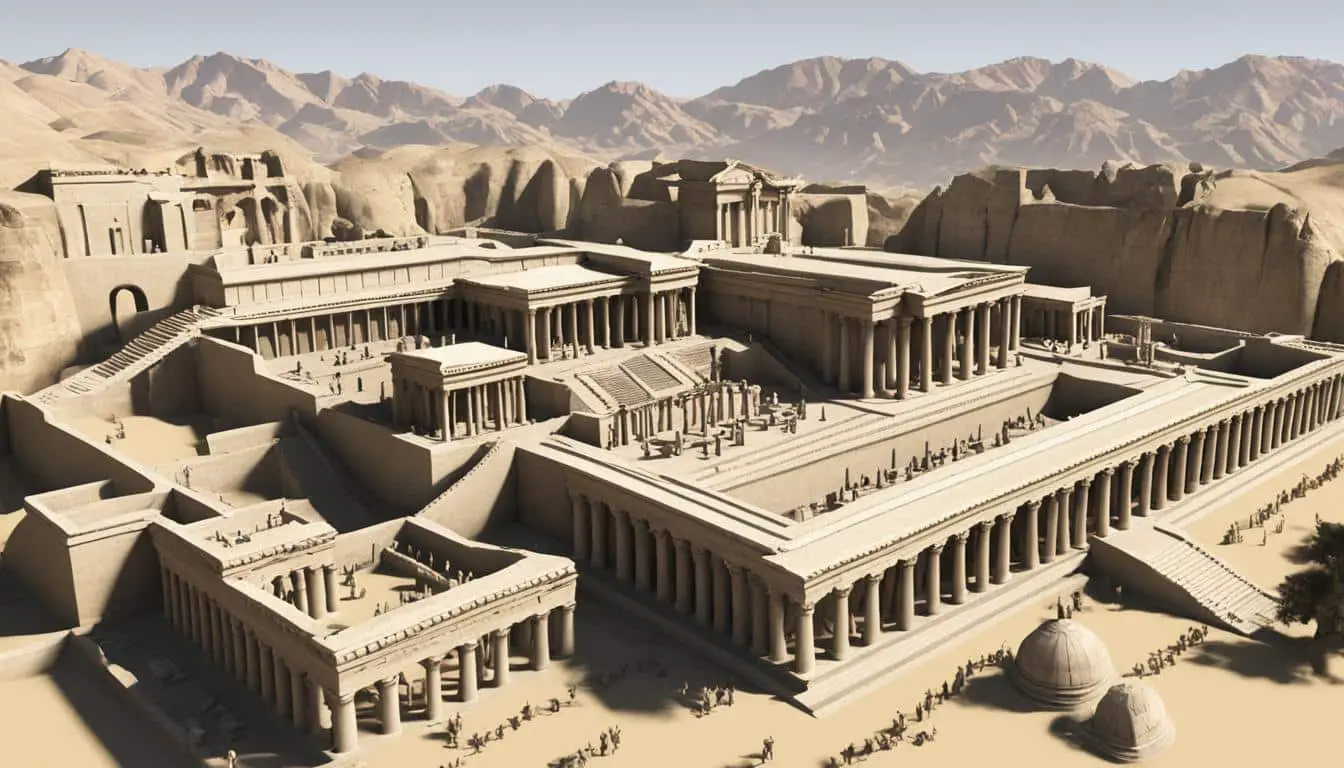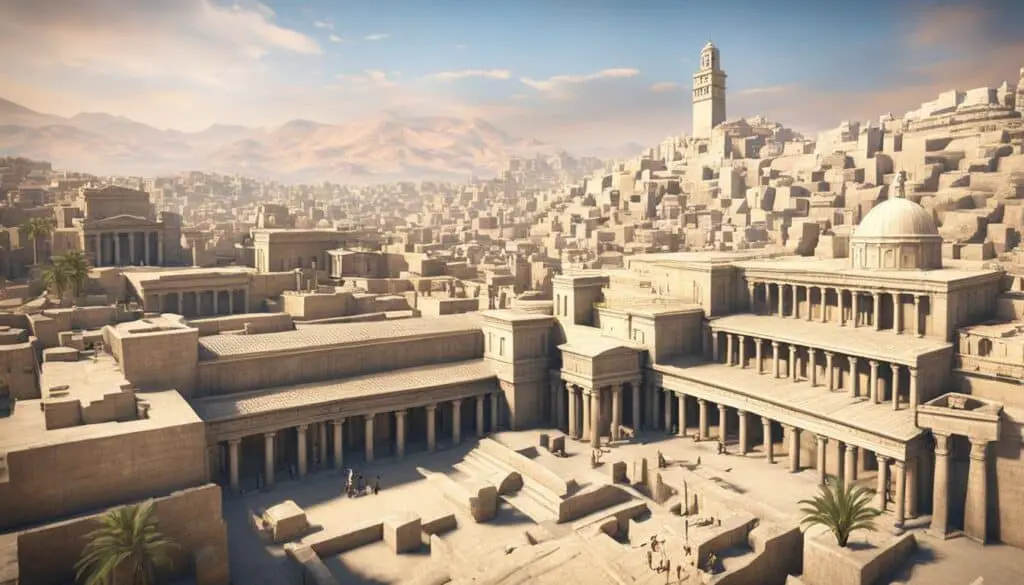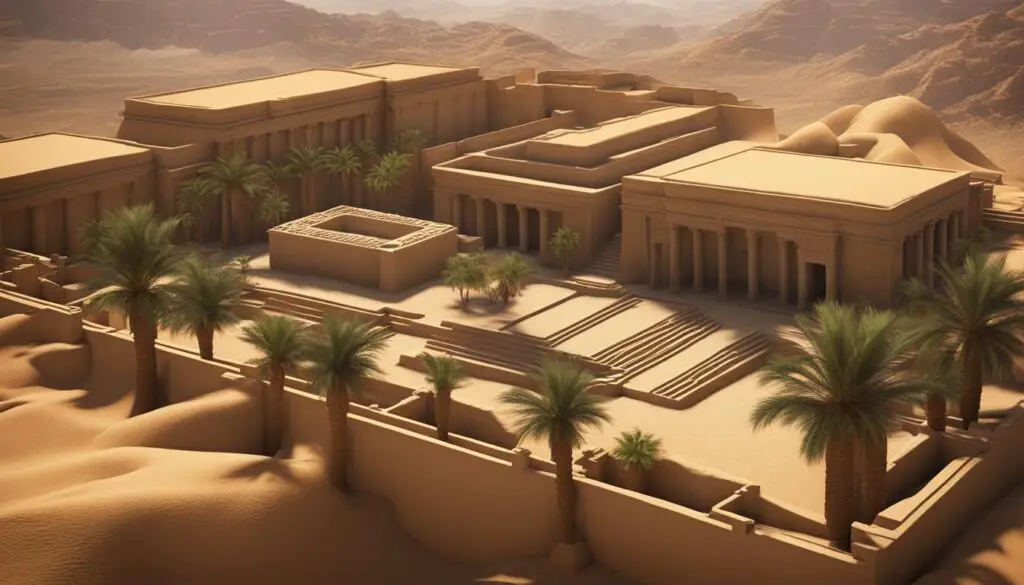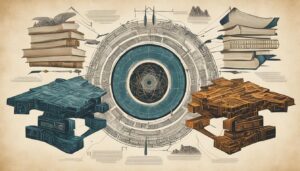
When it comes to exploring ancient biblical sites, traditional methods such as books and documentaries can only provide a limited understanding. That’s where 3D modeling technology comes in. With the use of cutting-edge software and historical data, these digital reconstructions offer a level of historical accuracy and immersive experience that was previously unimaginable.
By leveraging 3D modeling, users can now visually explore and interact with these ancient sites, gaining a deeper understanding of their historical significance and cultural context. From the grandeur of the Temple of Solomon to the awe-inspiring city of Jerusalem, the power of 3D modeling brings these historical landmarks to life.
Through digital reconstructions, we can see these sites as they once stood, complete with intricate details and structures. This not only allows for the preservation of fragile sites that may have been destroyed or damaged over time but also ensures that their legacy is not lost to history. From the architectural glory of ancient temples to the bustling streets of ancient cities, 3D modeling offers an unprecedented opportunity to delve into the past.
Key Takeaways:
- 3D modeling technology revolutionizes the exploration of ancient biblical sites, offering historical accuracy and immersive experiences.
- Virtual reconstructions preserve fragile sites and ensure their legacy is not lost to history.
- 3D modeling enhances education, research, and the understanding of ancient biblical sites’ architecture and cultural context.
- Virtual tours and interactive experiences enable individuals to explore these sites from anywhere, widening accessibility.
- 3D modeling plays a crucial role in the preservation of our cultural heritage, safeguarding ancient biblical sites.
The Power of 3D Modeling in Historical Preservation
One of the key benefits of 3D modeling in historical preservation is its ability to create accurate digital reconstructions of ancient biblical sites. By utilizing archaeological data, architectural plans, and historical records, these virtual models can represent the sites as they once stood, complete with intricate details and structures. This technology allows for the preservation of fragile sites that may have been destroyed or damaged over time, ensuring that their legacy is not lost to history.
“The accurate digital reconstruction of ancient biblical sites through 3D modeling technology is a groundbreaking development in historical preservation. These virtual models not only capture the architectural beauty of the sites but also serve as a valuable resource for understanding their historical significance.”
This innovative approach to historical preservation has several advantages. Firstly, it enables researchers and historians to study and analyze ancient biblical sites in a more comprehensive way. The detailed digital reconstructions provide a wealth of information about the sites’ layouts, architectural styles, and cultural context. This information can help answer critical questions about these sites and shed light on their historical significance.
Another significant advantage of 3D modeling in historical preservation is the accessibility it offers. While some ancient biblical sites may no longer be accessible to the public due to their remote locations or physical deterioration, virtual reconstructions provide an opportunity for anyone to explore and experience these sites from anywhere in the world. This accessibility promotes widespread awareness and appreciation for our cultural heritage.
Furthermore, 3D modeling technology plays a crucial role in preserving fragile or endangered sites. By creating digital replicas, historical sites can be safeguarded from natural disasters, human activities, and the passage of time. These replicas can serve as a reference point for restoration efforts and help ensure the longevity of these significant cultural landmarks.
The Benefits of 3D Modeling in Historical Preservation:
- Accurate digital reconstructions of ancient biblical sites
- Comprehensive understanding of site layouts, architecture, and cultural context
- Accessible exploration and experience for a global audience
- Preservation of fragile or endangered sites
Through the power of 3D modeling, historical preservation is taken to new heights. Digital reconstructions provide a window into the past, preserving the legacy of ancient biblical sites and enriching our understanding of human history.
| Advantages of 3D Modeling in Historical Preservation |
|---|
| Accurate representation of ancient biblical sites |
| Enhanced understanding of historical significance |
| Increased accessibility for global audiences |
| Preservation of fragile and endangered sites |
Enhancing Education and Research
In the realm of education and research, the utilization of 3D modeling has proven to be an invaluable asset, particularly in the study of ancient biblical sites. Through the creation of digital reconstructions, these models offer a unique visual experience that greatly enhances the learning process. Students and researchers alike can dive deep into the architecture, layout, and historical context of these sites, unraveling their mysteries and gaining valuable insights into the past.
With the aid of 3D modeling, researchers can now conduct virtual excavations, simulating the painstaking process of unearthing artifacts and uncovering hidden treasures. These virtual excavations provide a safe and controlled environment for hands-on learning, allowing students to develop crucial research skills while immersing themselves in the rich history of these ancient sites.
“The ability to simulate ancient rituals and practices through 3D modeling offers a unique opportunity to better understand the cultural significance of these sites,” says Dr. Sarah Thompson, an archaeologist specializing in biblical studies. “By digitally reconstructing these rituals, we can delve into their symbolism, explore theories surrounding their purpose, and gain valuable insights into the beliefs and practices of ancient civilizations.”
3D modeling has truly revolutionized the way we approach education and research in relation to ancient biblical sites. Through these digital reconstructions, we are able to bridge the gap between the past and the present, bringing these ancient sites to life and providing a captivating learning experience for students and researchers alike.
Benefits of 3D Modeling in Education
The integration of 3D modeling into education has brought forth numerous benefits for both teachers and students. Here are some key advantages:
- Visual Learning: 3D models offer a more engaging and interactive learning experience, making complex concepts and historical details easier to comprehend.
- Enhanced Retention: The visual nature of 3D models improves information retention, enabling students to remember important details for longer periods of time.
- Accessible Learning: With the digital nature of 3D models, students can access them anytime, anywhere, allowing for flexible learning opportunities.
The Role of 3D Modeling in Research
From a research standpoint, 3D modeling provides a versatile tool that allows for comprehensive analysis and exploration of ancient biblical sites. Here are some ways in which researchers are leveraging 3D modeling:
- Site Reconstruction: By digitally reconstructing ancient sites, researchers can gain a deeper understanding of the architecture, spatial relationships, and overall layout of these sites.
- Exploring Hypotheses: 3D models enable researchers to test and refine hypotheses by virtually manipulating the site, conducting experiments, and observing the potential outcomes.
- Preserving Fragile Sites: In cases where physical access to ancient sites may be limited or restricted, 3D modeling provides a means of preserving and studying these sites in intricate detail.
Case Study: Model of an Ancient City
| Date | City | Research Topic |
|---|---|---|
| 2018 | Bethlehem | Architectural Analysis |
| 2020 | Jericho | Urban Planning and Infrastructure |
| 2022 | Jerusalem | Religious Practices and Pilgrimages |
The table above demonstrates the application of 3D modeling in various research studies. By using digital reconstructions, researchers were able to delve into specific topics and gain valuable insights into ancient cities, such as Bethlehem, Jericho, and Jerusalem.
In conclusion, the integration of 3D modeling has significantly enhanced education and research in relation to ancient biblical sites. By providing a captivating visual experience and enabling hands-on exploration, these digital reconstructions have opened new doors for learning, analysis, and preservation. As we continue to embrace advancements in technology, we can expect even greater contributions from 3D modeling in both educational and research settings.
Virtual Tours and Interactive Experiences
With advancements in virtual reality (VR) and augmented reality (AR) technologies, 3D modeling of ancient biblical sites can offer immersive and interactive experiences to users. Virtual tours allow individuals to explore these sites from the comfort of their own homes, providing a sense of presence and realism. Users can navigate through the sites, interact with objects, and even engage in historical reenactments, further enhancing their understanding and connection to the past.

Through virtual tours and interactive experiences, users can truly immerse themselves in the ancient biblical sites, gaining a profound appreciation for their historical significance and cultural context. This technology allows for a more engaging and dynamic exploration, bringing the past to life like never before.
Preservation of Cultural Heritage
Preserving our cultural heritage is of utmost importance, especially when it comes to ancient biblical sites. 3D modeling has emerged as an invaluable tool in this endeavor, offering a means to document and safeguard these sites against the threats of destruction and decay. By creating accurate replicas through advanced digital reconstructions, we ensure the preservation and accessibility of these significant historical landmarks for future generations to cherish and learn from, even if the physical sites are no longer accessible.
Documenting Cultural Heritage
In the face of changing environments and human activities, many ancient biblical sites are vulnerable to irreversible damage. Through the use of 3D modeling technology, we can create detailed digital representations that capture the architecture, layout, and intricate details of these sites. This documentation process not only preserves the physical characteristics of historical structures but also provides a comprehensive record of their cultural and historical significance. With 3D models, we can accurately capture the essence of these sites and document them for posterity.
Safeguarding Against Destruction and Decay
Physical preservation of ancient biblical sites can be a challenging task, especially with the passage of time and the potential threats posed by natural disasters, urban development, and vandalism. However, with 3D modeling, we can create virtual replicas that stand as timeless monuments, ensuring the perpetuation of our cultural heritage. These accurate virtual representations not only safeguard the architectural aspects of the sites but also preserve the context and historical narratives associated with them.
Furthermore, these 3D models serve as backups, guarding against the loss of information caused by unforeseen events. Even in the face of the eventual decay or destruction of the physical sites, the digital reconstructions can continue to provide invaluable insights and knowledge.
Enabling Virtual Exploration and Education
The digital reconstructions made possible by 3D modeling technology cater to a wider audience, enabling virtual exploration and education. By providing detailed and immersive experiences, individuals from all over the world can engage with these ancient biblical sites and gain a deeper understanding of their cultural and historical significance.
Using web-based platforms or mobile applications, users can embark on virtual tours, guiding them through these sites in a way that transcends geographical boundaries and time constraints. They can interact with the model, examine intricate details, and even participate in educational activities, such as virtual excavations or historical reenactments. This accessibility brings these ancient sites into the homes and classrooms of people, fostering a sense of connection and appreciation for our shared cultural heritage.
The Role of 3D Modeling in Cultural Preservation
3D modeling has become an indispensable tool in the preservation of cultural heritage, particularly for ancient biblical sites. By creating accurate replicas, documenting the sites, and enabling virtual exploration, 3D modeling ensures the continuity of our cultural legacy. These digital reconstructions allow us to protect, conserve, and transmit the historical knowledge embedded within these sites to current and future generations.
Through the collaborative efforts of archaeologists, historians, and technological experts, we can harness the power of 3D modeling to safeguard and celebrate our collective past, ensuring its preservation for centuries to come.
 <!–
<!–
Table: Comparison of 3D Modeling in Cultural Heritage Preservation
| Advantages | Challenges |
|---|---|
| 1. Accurate documentation and preservation of architectural details | 1. Costly and time-consuming process |
| 2. Virtual accessibility for education and research | 2. Limited data availability for accurate reconstructions |
| 3. Safeguarding sites against destruction and decay | 3. Technological limitations and compatibility issues |
| 4. Sharing and dissemination of historical knowledge | 4. Balancing digital representation with physical preservation |
–>
Advancements in Technology and Accessibility
With the continuous advancements in technology, the field of 3D modeling is making significant strides in making digital reconstructions of ancient biblical sites more accessible to a wider audience. These technological innovations are transforming the way we experience and interact with the past, allowing individuals to explore these historical landmarks with ease and convenience.
Accessibility:
One of the key breakthroughs in accessibility is the development of web-based platforms and mobile applications that allow users to access and engage with 3D models of ancient biblical sites using their smartphones, tablets, or computers. This means that regardless of location or time constraints, individuals can now embark on virtual journeys to these ancient sites, immersing themselves in the rich history and cultural significance they hold.
Advancements in Technology:
Technological innovations have facilitated the creation of highly detailed and realistic 3D models, capturing even the most intricate architectural elements and historical features of ancient biblical sites. Through advancements such as photogrammetry, laser scanning, and AI-assisted modeling, these digital reconstructions are more accurate and visually stunning than ever before. This level of authenticity and attention to detail ensures a truly immersive experience for users, encouraging a deeper understanding and appreciation of these ancient sites.
Enhancing Accessibility with Virtual Reality (VR):
The integration of virtual reality (VR) technology with 3D modeling has further enhanced accessibility and immersive experiences. With the use of VR headsets, individuals can now embark on virtual tours of ancient biblical sites, feeling as though they are physically present within these historical environments. This technology has the power to transport users back in time, allowing for a more engaging and memorable exploration of these significant landmarks.
Democratizing Access to Historical Knowledge:
This increased accessibility to 3D models of ancient biblical sites has democratized access to historical knowledge. People from all walks of life, regardless of their physical abilities, geographical location, or socioeconomic background, can now gain insights into these ancient sites and their cultural significance. By breaking down barriers and making historical information readily available, 3D modeling technology contributes to a more inclusive and informed society.
Table: Accessibility and Advancements in Technology
| Advancements in Technology | Benefits in Accessibility |
|---|---|
| Incorporation of web-based platforms and mobile applications | Enables users to access 3D models using smartphones, tablets, or computers from anywhere |
| Photogrammetry, laser scanning, and AI-assisted modeling | Creates highly detailed and accurate digital reconstructions for a realistic experience |
| Integration of virtual reality (VR) technology | Offers immersive virtual tours, enhancing the sense of presence and exploration |
| Democratizing access to historical knowledge | Allows people from diverse backgrounds to learn and engage with ancient biblical sites |
Conclusion
3D modeling has revolutionized the way we explore and understand ancient biblical sites. Through the power of technology, these digital reconstructions provide an immersive experience that brings the past to life with unparalleled historical accuracy.
From an educational standpoint, 3D modeling enhances learning and research by allowing users to visually explore and analyze the architecture, layout, and historical context of these sites. Virtual excavations and historical reenactments deepen our understanding and connect us to the people and events of the past.
Moreover, 3D modeling plays a vital role in the preservation of our cultural heritage. By creating accurate replicas, these digital reconstructions safeguard ancient biblical sites that may be at risk of destruction or decay. They ensure that future generations can continue to learn from and appreciate these significant historical landmarks.
As technology continues to advance, we can expect even more remarkable experiences and insights into our rich history. With its ability to offer an immersive and accurate representation of ancient biblical sites, 3D modeling opens doors to a deeper understanding of our past and a greater appreciation for the cultural heritage that shapes our present.
FAQ
What is 3D modeling?
3D modeling is the process of creating a digital representation or reconstruction of an object or environment using specialized software.
How does 3D modeling bring ancient biblical sites to life?
3D modeling utilizes cutting-edge technology and historical data to create accurate virtual reconstructions of ancient biblical sites, allowing users to explore and interact with them visually.
Why is historical accuracy important in 3D modeling?
Historical accuracy is crucial in 3D modeling as it ensures that the digital reconstructions accurately represent the original sites, providing an authentic experience and enhancing our understanding of their historical significance.
What are the benefits of 3D modeling in historical preservation?
3D modeling allows for the creation of accurate digital reconstructions of ancient biblical sites, preserving their architectural details and structures for future generations, even if the physical site is no longer accessible or at risk of destruction.
How does 3D modeling enhance education and research?
3D modeling provides educators and researchers with a unique visual experience, allowing for in-depth analysis of the architecture, layout, and historical context of ancient biblical sites. It enables virtual excavations, simulations of ancient rituals and practices, and exploration of theories about the sites’ purpose and significance.
What are virtual tours and interactive experiences in 3D modeling?
Virtual tours and interactive experiences in 3D modeling enable individuals to explore ancient biblical sites through immersive technologies such as virtual reality (VR) and augmented reality (AR). Users can navigate, interact with objects, and engage in historical reenactments, enhancing their understanding and connection to the past.
How does 3D modeling contribute to the preservation of cultural heritage?
3D modeling plays a crucial role in documenting and safeguarding ancient biblical sites that may be at risk of destruction or decay. By creating accurate digital replicas, it ensures that future generations can continue to learn from and appreciate these significant historical landmarks.
How has advancements in technology improved accessibility to 3D modeling of ancient biblical sites?
Advancements in technology have made digital reconstructions of ancient biblical sites more accessible to a wider audience. With web-based platforms and mobile applications, individuals can now explore and engage with these models using their smartphones, tablets, or computers, democratizing access to historical knowledge.








